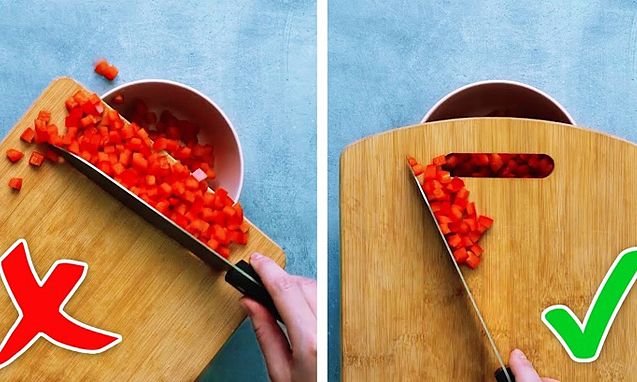Cutting boards are kitchen utensils that every family has. Do you know why every cutting board has a hole?
Why is there always a hole on the cutting board?
Standard cutting boards always have holes at the edge. Its use is not just to hang or hold easily. In fact, this special structure was born to serve a completely different purpose.

When slicing food, especially into small pieces, you will have more or less difficulty putting the finished product into a bowl or plate. Food can easily fall out and will take time to wash. If you pick your hands, especially with cooked food, the possibility of hand contamination is very high, not to mention it also looks unhygienic.
The correct way to do this is to use a knife as soon as you finish slicing and push the food through the hole so that it falls easily onto the tray or dishes below. This method applies to diced foods or minced meat.

However, if you use the hole in the cutting board for this purpose, you must remember that when cleaning the cutting board, you need to clean this area thoroughly to avoid letting the hole area get dirty or moldy, which will do more harm than good.
Additionally, you can use it to hang on the wall when not in use.
Some effective ways to clean wooden cutting boards
Use lemon and salt
This is one of the most effective and safe ways.
Cut the lemon in half, squeeze the juice or you can rub it on a cutting board, then sprinkle salt into the lemon juice area. You should choose coarse-grained ones to absorb lemon juice and rub on the cutting board, or for cutting boards with smooth surfaces, you can use baking powder instead of salt.
Use a cut piece of lemon to rub the surface of the cutting board in a circular motion. Add salt to dissolve in the lemon to clean the cutting board. Pay attention to scrubbing thoroughly on areas with stains. Then rinse with clean water, use a dry towel or paper to remove all the water from the cutting board surface.
Use soap
Dilute the soap in hot water and soak a towel in the mixture, then wring it out gently and wipe the entire surface of the cutting board. Repeat several times and scrub vigorously on heavy stains or stains and then rinse thoroughly with clean water.
Use bleach
Mix 1 tablespoon of bleach into 1.5 liters of water, then put it in a spray bottle and spray evenly on the cutting board surface and leave for about 10 minutes, then rinse with warm water and dry the cutting board surface. This method also helps eliminate bacteria effectively, but you need to thoroughly wash the cutting board with warm water and be careful not to let the bleach get on kitchen utensils or towels.
Things to avoid when using wooden cutting boards
Do not soak cutting boards in water. Wooden cutting boards are very porous and can become soaked in water, leading to cracks and reduced usage time.
Do not put cutting boards in the dishwasher unless they are labeled dishwasher safe. Many studies show that dishwashers can cross-contaminate bacteria from cutting boards to dishes.
Do not use regular cooking oil to maintain cutting boards because it can cause rot and lead to an unpleasant odor.
Do not use wooden cutting boards that are broken or cracked because the cracks are difficult to clean. Cracks will be a hiding place for bacteria and can contribute to food poisoning. It’s best to replace the cutting board with a new one immediately.












